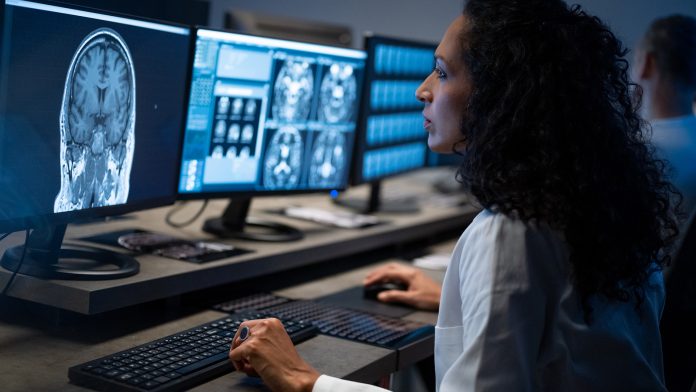
Clinical trial results suggest a new Artificial Intelligence (AI) device could help clinicians monitor traumatic brain injury.
Traumatic brain injury is an injury to the brain caused by a trauma to the head region. These are typically caused by road traffic accidents, assaults, falls, and accidents. How a traumatic brain injury affects a person depends on the individual and several factors such as location and severity.
Traumatic brain injuries require constant monitoring during treatment, and intracranial probes are utilised in neurocritical care settings to monitor biomarkers. However, only one biomarker can typically be measured at one time, and others can monitor multiple biomarkers but can cause further tissue damage or infections.
Imperial College Researchers have developed a patient monitoring system that observes several biomarkers following traumatic brain injury. They published their findings in Matter.
AI device for traumatic brain injury monitoring
The device combines the ability to monitor four biomarkers with machine learning algorithms that use previous data to predict biomarker concentrations based on obtained data in real-time.
Lead author Dr Yubing Hu, at Imperial’s Department of Chemical Engineering, said: “This is a promising breakthrough. Our promising results indicate both accurate biomarker monitoring and precise predictions of injury progression which, after further development, could help clinicians monitor both patients’ brain health and response to treatment.”
The monitoring system is made of a flexible silica-based optical fibre that is inserted into brain tissue to monitor the cerebrospinal fluid (CSF) – the liquid surrounding the brain and spinal cord. On the tip of the fibre, four sensing films measure levels of one biomarker simultaneously and continuously each within the CSF: pH, temperature, dissolved oxygen, and glucose. The firms are covered with a black sheath to reduce background noise and improve data precision.
Testing the monitoring system
The researchers tested the device by continuously monitoring levels of the biomarkers in a lamb brain under various states. The lamb brain, which had not suffered a traumatic brain injury and was classified as healthy, was suspended in artificial CSF that the researchers could tweak to mimic the brain chemistry of mild and severe traumatic brain injury.
First author Yuqian Zhang, a PhD candidate in the Department of Chemical Engineering, said: “Our device collects a breadth of medical data that’s only currently achievable with many different sensors. The optical fibre sensor device integrated with artificial intelligence (AI) to reduce cross-talks.”
Co-author Dr Nan Jiang of Sichuan University said: “The device demonstrated high accuracy in continuously measuring each biomarker during healthy, mild TBI, and severe TBI disease states.”
The device was highly sensitive (ability to detect trace amounts of biomarkers), selectivity (the ability to discern between biomarkers), stability (the ability to provide long-term monitoring with minimal signal drift), biocompatibility (the ability for the sensor to interact safely with brain tissue during long-term implantation), and robustness.
The machine learning models accurately predicted biomarker concentrations in real-time using readouts from a library of previous measurements. It also identified the transition between different stages of traumatic brain injury simulated by researchers.
Dr Ali Yetisen who led the research team at the Department of Chemical Engineering, said: “Our study showed the device’s ability to dynamically monitor multiple biomarkers to assess metabolic changes in the brain. It continuously reflects the injury’s status, which could help neurosurgeons follow the disease course precisely to make evidence-based clinical decisions and treatment.”









